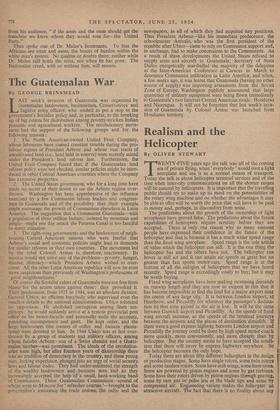Realism and the Helicopter
By OLIVER STEWART TWENTY-FIVE years ago the talk was all of the coming era of private flying, when ' everybody ' would own a light aeroplane and use it as a normal means of transport. Today the talk is about helicopter terminal services and of the time when inter-city communications on all the shorter ranges will be assured by helicopters. It is important that the travelling public should try to make up its mind on the potentialities of the rotary wing machine and on whether the advantages it may be able to offer will be worth the price that will have to be paid in money and, perhaps, in discomfort from noise. of the designs seems to enlarge the future possibilities. Air line operators have stimulated design by asking for twin-engined aircraft capable of taking 40 passengers. Perhaps the most highly developed machines are two of the Sikorsky helicopters, one small and one much larger, both built under licence in this country by Westland. Perhaps the most interesting from the design point.of view are the Rotodyne made by Fairey and the French Djinn made by the nationalised company of the Sud Ouest.
Performance figures do not show any marked differences between one type and another. All these aircraft can hover in still air, can take off without forward run, and can land without run. Their top speeds may go up to about 130 miles an hour, but mostly they cruise at something less than 100 miles an hour. The noisiest helicopters are those with jet drive at the rotor blade tips. Some aircraft of this kind make a noise like a rapid succession of explosions and will certainly disturb those who have already complained about the noise of ordinary piston-engined helicopters. The quietest helicopter is the French Djinn, whose rotor is driven not by jets with burners, but by simple compressed air. This is generated by a gas turbine situated behind the passenger cabin. It is pumped out along the hollow rotor blades to nozzles at the tips. The Djinn is quiet'and manoeuvrable, and it has recently established an inter- national altitude record. But only two-seat aircraft of this type have yet been built.
All the fuss that has been made about the regulation of helicopter flights over cities is the outcome of the fact that all helicopters at present working in Great Britain must make a fairly steep descent and a forced landing if an engine fails. The multi-engined trustworthiness of fixed wing aircraft ,is derived from the ability of the machine to remain in level flight after an engine fails. It is doubtful if any twin-engined heli- copter at the present time can remain in level flight after the failure of one engine when it is fully loaded. Another fact Which influences safety is the basic strength and reliability of the structure. One helicopter, which suffered a broken rotor blade in full flight, crashed without killing its pilot. More usually the death of all on board may be expected from blade failure, but helicopter engineers point out that the same is true of wing failure in an ordinary aeroplane.
An aid to seeing helicopter prospects in perspective is pro- vided by certain practical experiences. In July, 1952, the Atlantic Ocean was crossed by helicopter for the first time. Sikorsky S-55 machines flew over by way of Goose Bay, Green- land and Iceland. Many successful mail-carrying services have been run with helicopters. The Post Office obtained 98.4 per Cent. regularity in its East Anglian experimental mail service which was run during the hours of daylight. By night the regularity was 77.1 per cent. The first experimental scheduled iassenger service was between London and Birmingham, but ncomparably the most important helicopter passenger service was the first international one instituted in September of last fear by Sabena, the Belgian company. It serves seven cities in our different countries. All the cities have provided their own heliports and it has been found in practice that, with the Sikorsky 55, the turn-round time at the points of call is only three minutes. This. Belgian service indeed must be counted the most successful passenger helicopter service yet run. We return finally to the basic commodity which helicopters have to sell : speed range. Because of their speed range they benefit from every kind of land transport inefficiency, whether it be inadequate roads, lack of parking space, badly-run rail- ways or ill-regulated traffic. The helicopter is not\ fast and it is unlikely that it will ever challenge the fixed wing aeroplane in top speed, but it can land on a tennis court and it can take off vertically. As the roads become more congested so those two abilities become more valuable. Nobody knows yet how expensive speed range is to buy, for the operating statistics are Incomplete. It appears at the moment as if the future of the helicopter will be dependent upon just how much the traveller —or, where there are State airlines, the taxpayer—will be pre- pared to pay to escape from the dirty, smelly, noisy, frustrating, wasteful and inefficient traffic chaos on the roads.



































 Previous page
Previous page